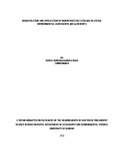| dc.description.abstract | World biodiversity is decreasing at an unprecedented rate. This challenge has raised the need for global policy intervention in the form of biodiversity related Multilateral Environmental Agreements (MEAs). Biodiversity MEAs have enabled developing countries to improve environmental governance through the implementation of national policies. The problem being investigated was that in spite of Kenya being a signatory to all biodiversity MEAs and having many biodiversity related policies and legislations; its biodiversity is declining. The aim of the study was 1) to evaluate the domestication and integration in the national policies of the following five biodiversity MEAs in Kenya (a) Convention on Biological Diversity (CBD), (b) Convention on International Trade in Endangered Species of Plants and Animals (CITES), (c) Convention on Conservation of Migratory Species of Wild Animals (CMS), (d) Convention on Wetlands of International Importance especially as Waterfowl Habitat (Ramsar Convention) and, (e) World Heritage Convention (WHC); 2) assess capacity of MEA focal institutions; 3) establish the achievements and challenges in selected MEA study sites including MEA designated and tentatively listed sites and the country’s points of entry and exit; and 4) assess the level of MEA awareness amongst the local communities. The general hypothesis used to guide the study objectives was that MEAs were poorly reflected in national biodiversity policies and poorly implemented at institutional levels, hence the continued loss of biodiversity in Kenya.
To realize the study objectives, literature review was done on the biodiversity MEA implementation and a conceptual framework was developed. Field data collection was done using random sampling for household respondents in the MEA study sites and purposive sampling for institutional focal respondents and other government officials. A total of 20 institutional and 2,109 household respondents were sampled from the study sites. The data was subjected to descriptive statistics so as get measures of distribution tendencies, dispersions, differences and associations and inferential statistics, namely Kruskal-Wallis H-test to test the hypothesis that MEAs are poorly reflected in national biodiversity policies at institutional levels; Chi-square to test the hypothesis that there is no difference between the local people’s MEA awareness with the distance from the conservation and operational areas and Paired t-test to test the hypothesis that there is no difference in the typology of threats affecting the domestication and application of various biodiversity MEAs in Kenya.
viii
Comprehensive policy analysis of domestication and application of global biodiversity MEAs at national level indicated that the CITES ranked the top with 24.8% integration of global obligations, followed by the CBD (20.9%), CMS and WHC (19.1% each) while the Ramsar Convention had the lowest integration status (18.8%). The study established that domestication and implementation of biodiversity MEAs in Kenya is weak because not all MEA obligations are addressed in the biodiversity policies. Furthermore the study also found that many biodiversity related policies which are supposed to serve as vehicles for the MEA domestication and implementation are in the draft form and are yet to be ratified by the national government.
The study findings further indicated that the Ramsar Convention had the best capacity at 83.3% in terms of highly educated and long serving staff, funding, vehicles and ICT followed by the CBD (66.7%) and the CITES, CMS and the WHC having 50% of the needed capacity each. In terms of public awareness, education was found to play the most important role in creating public awareness of MEAs, with the Ramsar Convention ranking the top at 97.1%, followed by the CITES at 90.6%, CBD at 87.6%, WHC at 54.2% and CMS ranking the lowest at 0.8%. Similarly the aspect of distance from the MEA sites was also found to play an important role. The results indicated that as one moves further away from the MEA sites, the less aware one becomes of the MEAs. In terms of gender, results indicated that males were better aware of the MEA status than the females. The findings on the level of MEA awareness was better for shorter duration of residence around the MEA sites as the message of MEAs had been spreading in the last few years.
On the overall, institutional capacity was found to be generally poor in terms of personnel, vehicles and funding. Furthermore the institutional capacity responsible for implementing the biodiversity policies was weak in terms of public involvement in biodiversity conservation. Formal education was found to play a significant role in the level of MEA awareness by the citizenry. Based on the findings of this study, recommendations include amendments in the already gazetted policies, adopting draft policies, improving institutional capacity, involving communities more at grassroot levels and having more environmental education institutions to cater for environmental awareness around MEA sites. | en_US |



